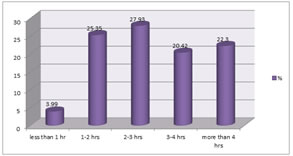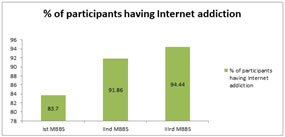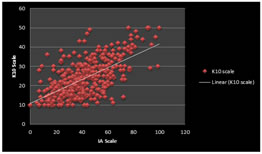|
Table of Content - Volume 19 Issue 2 - August 2021
Internet addiction and its association with psychological distress among undergraduate medical students of northern Maharashtra
Yogita Gopal Bavaskar1, Ganesh Shrihari Lokhande2, Jitendra Bhaskar Surwade3, Vilas Raghunath Malkar4*, Jaiprakash Ramanand5, Shriram Gosavi6, Ramesh Devidas Pawar7
{1,4,6Associate Professor, 2,3,7Assistant Professor, Department of Community Medicine}, 5Dean, Government Medical College, Akola, Maharashtra, INDIA. Email: yogitabavaskar@gmail.com
Abstract Background: Internet has become an indispensible tool for medical graduates for academic as well as social purpose. Stress of medical education and lack of parental control in college life, are likely to lead to internet addiction in them, which in turn can cause psychological problems. Objective: The study was planned to assess the extent of internet addiction and its association with psychological distress Methods: The cross sectional study was conducted among 426 undergraduate medical students of three Government medical colleges of Maharashtra. The information regarding socio-demographic data, total duration and pattern of internet use was collected. Internet addiction test by Dr Kimberly Young was used to assess internet addiction. It is a 20 items questionnaire that measures mild, moderate and severe level of internet addiction. Kessler Psychological Distress Scale (K10) was administered to study participants. It measures distress based on questions about anxiety and depressive symptoms that a person has experienced in the last 4 week period. Data was analyzed using SPSS version 23. Results: Out of 426 participants, 31.6% had moderate- severe internet addiction and 41.3% were screened positive for moderate-severe level of psychological distress. Statistically significant association was found between Internet addiction and presence of distress, i.e. anxiety and depression (P value < 0.05). Conclusion: Internet addiction was present in significant number of medical undergraduate students. It is seen that other psychological problems coexist with internet addiction. Therefore interventions should be planned to manage internet addiction as well as associated psychological stressors such as anxiety and depression. Keywords: Internet addiction, medical undergraduate students, psychological distress, anxiety, depression.
INTRODUCTION Internet has become an indispensible tool for medical graduates for academic as well as social purpose. Stress of medical education and lack of parental control in college life are likely to lead to internet addiction in them which in turn can cause psychological problems. “Internet Addiction is an individual's inability to control his or her own use of the Internet causing disturbances and impairment in fulfillment of work, social and personal commitments”.1,2 Internet addiction during undergraduate college days can hamper the academic learning of the student. The coexistence of depression and internet addiction is commonly observed among the young individuals. The presence of low self-esteem, low motivation, fear of negative evaluation, social avoidance observed in depressed individuals are hypothesized to lead to excessive/addictive usage of the Internet in depressed individuals 3 . Social isolation caused by Internet Addiction may also lead to depression. Researchers have suggested that availability of online learning, modern gadgets, unstructured timetable and lack of parental control can contribute towards a higher predominance of Internet addiction and its negative outcomes among medical students 4. Estimating the prevalence of Internet addiction and psychological problems among medical students and studying it’s relationship with psychological distress can give new evidence in this domain. It will help to initiate preventive strategies and mitigation measures to keep control on this silent public health problem. With this perspective present study was planned among the medical undergraduate students.
Objectives:
MATERIALS AND METHODS The cross-sectional study was conducted among undergraduate medical students of three Government medical colleges of northern Maharashtra during September- November 2019. 426 undergraduate MBBS students from first year to final year participated in the study. The nature of study was explained to the students and Google forms were used to collect data from each consenting student of the three medical colleges. In the first section of the google form, purpose of the study was explained and consent to participate was taken from the participants. The sample size was calculated considering an estimated prevalence of Internet Addiction as 25% 5 at 95% confidence interval and 5% allowable error, which came out to be 300. The data was retrieved in excel sheet when the sample size reached 426. The information regarding socio-demographic data, total average internet use duration and pattern of internet use, was collected. Internet addiction test by Dr Kimberly Young was used to assess internet addiction. It is a 20 item self-reporting questionnaire based on a 5-point Likert scale to screen for internet addiction and its severity 6. It has been validated in various countries and also in some studies in India. The severity of addiction is evaluated in the following manner: scores of 0–30 as no, 31–49 mild, 50–79 moderate, and 80–100 severe form of impairment. Those having moderate or severe impairments are classified as cases of possible Internet Addiction. Kessler Psychological Distress Scale (K10) was administered to measures psychological distress based on questions about anxiety and depressive symptoms that a person has experienced in the last 4 week period. The K10 scale involves 10 questions about emotional states each with a five-level response scale. The measure is used as a quick screen to identify levels of distress. Each item is scored from one ‘none of the time’ to five ‘all of the time’. Scores of the ten items are then summed, yielding a minimum score of 10 and a maximum score of 50. Score categorized as likely to have a mild disorder if between 20 – 24, likely to have a moderate or severe disorder if the score is between 25 – 29 and 30 – 50 respectively 7. Data was analyzed using SPSS version 23. Descriptive statistics have been presented in the forms of percentages and proportions. Correlation coefficient was used to measure the association of Internet Addiction with psychological distress status. Institutional ethics committee permission was taken prior to start of the study. Permissions were obtained from the heads of the respective colleges to conduct the study. Confidentiality of the responses was ensured. The results of the study were shared with the students. A lecture on stress management was arranged in all the three institutes and students were directed to seek psychiatric help if needed. RESULTS Out of 426 participants, 242 (56.81%) were male, majority were first- or second-year students (90.84%). The mean age of respondents was 19.89 years. Majority of the respondents were living in hostels, 355(83.33%) and were hailing from an urban area 265(62.2%). Table 1: Socio-demographic characteristic wise distribution of study participants
Graph 1: Average time spent on internet everyday by study participants It was observed that out of 426 study participants 206 (48.35%) spent on an average 2-4 hrs time on internet while, 95(22.3%) students spent more than 4 hrs on internet every day, apart from the academic use.
Table 2: Distribution of students as per level of internet addiction
132 (30.98%) participants had moderate- severe internet addiction, level of addiction was mild in 243(57.04%) study participants and 51(11.97%) students were not having internet addiction.
Table 3: Gender-wise distribution students as per level of internet addiction
X2=4.695, df=3, p=0.1955 (Not Significant) Internet addiction was found to be more prevalent in male participants compared to the female participants.
Graph 2: Academic year wise distribution of participants with Internet addiction There was increasing trend of internet addiction from Ist year MBBS students to IIIrd year MBBS students.
Table 4: Residential stay-wise distribution of students as per level of internet addiction
X2=0.3608, df=2, p= 0.548 (Not Significant) Internet addiction was observed in 314 (88.45%) students residing in hostel compared to 61 (85.91%) students residing either with their family or living in rented house.
Table 5: Duration of internet use and risk of Internet addiction
X2= 42.12, df=4, p= <0.0001 (Significant) More than 60% students with moderate internet addiction had daily use of internet for more than 3 hrs while 90% of the participants with severe internet addiction used internet for more than 4 hrs. It indicates that participants who were using internet for longer duration were more prone for moderate to severe level internet addiction.
Table 6: Distribution of study participants as per psychological distress
It was observed that out of 426 study participants screened for psychological distress 177 (41.54%) were screened positive for moderate-severe level of psychological distress, 78(18.31%) had mild distress and 171(40.14%)of the respondents screened to be not suffering from any psychological distress.
Graph 3: Correlation between IA score and psychological distress score based on K10 A positive correlation was found between Internet addiction and psychological distress (depression and anxiety) (R= 0.63; P ≤ 0.001). The students, who have higher internet addiction, were likely to have psychological distress and vice versa.
DISCUSSION Excessive use of internet is becoming a common problem especially in young adults. It is a one of the commonest addiction of 21st century. We found that 30% of the students who participated in the study were having internet addiction. This is alarming as students are losing their valuable study time. 42% students were found to be spending more than 3 hrs a day on internet for non academic purpose. The findings of the study were similar to the observations by the Aman Gupta et al. 5 and meta analysis done by Melvyn W. B. Zhang on a pooled sample of 3651 medical students8 Sharma B et al. 9 revealed prevalence of internet addiction in 44% of the undergraduate students. Slightly lower prevalence was found in the study done by Nitin Anand et al. in south India . Internet addiction was observed more in boys compared to the girls. Similar findings were observed in the study conducted by the Farrukh Ansar et al. 11. Various meta-analyses and review articles have shown that male students are more prone to developing Internet addiction than the girls 12, 13. Internet addiction was observed similar in participants who were staying in the hostel compared to participants living with their families. But in a studies done in India 4 and Iran 14 IA was higher among the students who stay independently. The experience of loneliness, boredom, and availability of privacy, easy access to the internet and lack of parental control may escalate the excessive use of the Internet. In the present study increasing trend of internet addiction was observed with each year of academic course, which suggests that as an individual’s age increases their risk for addictive internet use becomes higher. Similar findings were seen in the study conducted by the Khan I Aqueel et al.15 Participants who were using internet for longer duration were more prone for moderate to severe level internet addiction. Study conducted by the Nitin Anand et al. 10 observed that university students who were using internet for more than 3 hours per day for non academic activities had higher levels of IA. Increase in the duration of internet use associated with increasing severity levels of IA which was consistently suggested by research evidence from many studies. 16,17,18 Prevalence of psychological distress was also found be very high i.e. in 40% of the study participants. Masoudi et al. concluded that 52.4% of students at Tehran University of Medical Scienceswere suffering from mental health disorders 19. Similarly, in a study done by Yavarian et al. 20 demonstrated that 45.8% of students were having different degrees of mental health disorders. In the present study strong positive association was found between depression and IA. A study conducted by Panicker and Sachdev 21 and Ayaset al., 22 also reported a significant association between internet addiction and depression. A study by Akin and Iskender 23 also observed a positive correlation between internet addiction and anxiety (r = 0.63). Various national and international studies revealed significant positive relation between internet addiction and anxiety 24,25,26,27. Whether depression is leading to excess use of internet as an escape mechanism or excess use of internet is leading to depression is still debatable. But, there is need to address both the issues as they are usually seen coexisting.
CONCLUSION Internet addiction was present in significant number of medical undergraduate students. It is seen that other psychological problems coexist with internet addiction. Therefore interventions should be planned to manage internet addiction as well as associated psychological stressors such as anxiety and depression.
REFERENCES
Policy for Articles with Open Access
|
|
||||||||||||||||||||||||||||||||||||||||||||||||||||||||||||||||||||||||||||||||||||||||||||||||||||||||||||||||||||||||||||||||||||||||||||||||||||||||||||||||||||||||
 Home
Home



